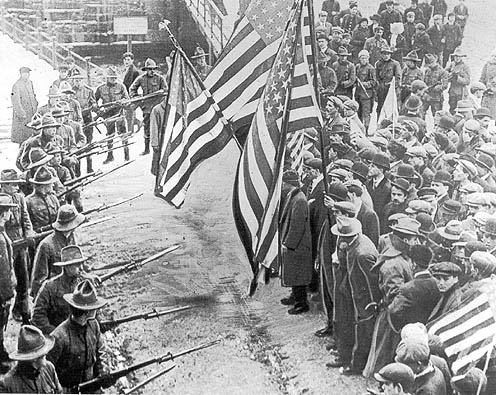40.1 – Introduction to Heterodox Perspectives on Work and Income

Bread and Roses
In 1912, the American Woolen Company employed around 32,000 men, women, and children in its Lawrence, Massachusetts textile mill. Working conditions were harsh, as were the living conditions in local housing, much of which was owned by the same company. Over a third of the adult workers in the mill would not live to see 25, and the town had the fifth highest child mortality rate in the country.
When workers, organized by the Industrial Workers of the World, decided to strike for higher pay at a 54-hour work week, the local and state governments responded with armed militiamen and jail time for many strikers. As the strike continued through the cold winter months, mothers began to take their children (some of whom were striking workers themselves) to stay with sympathetic families in nearby cities. The government again intervened on behalf of the American Woolen Company, and on February 24th and 25th police and soldiers clubbed and arrested several women and children as the children attempted to board a train for Philadelphia.
A strike is an opportunity to see the relationships of power between different classes. When workers go on strike, they are refusing to do the work of producing until the owners of the business agree to their demands (for better pay and working conditions and the like). In effect, they’re demonstrating that, while workers can’t make a living without employment from the business, the business owners can’t make a profit without the workers either. As the Lawrence workers saw, however, there is often the potential for violence behind the business’ side of this interdependence.
Can all of this strife be neatly theorized in the simple terms of imperfectly competitive labor markets? Heterodox economists would say no. What is needed is an alternative framework to understand the conditions of work and the determinants of who gets paid how much and why, one that recognizes the full extent to which economic and political power is exercised between different groups in the economy.
Chapter Objectives
In this chapter, you will learn about:
- Labor Productivity and Income, Post-WWII
- Class
- Understanding Class Distinctions Today
The relationship between employer and employee is surely one of the most fundamentally important topics in economics. Is it, or could it be, a relationship of equals? Or is it fated to be a relationship of power, subordination, and occasionally even violence?
Orthodox economics suggests that a level playing field between employers and their employees is assured by (perfect) competition in the labor markets. Heterodox economists, on the other hand, reject the use of concepts such as supply and demand or profit maximization in the analysis of this relationship, and instead refer to the economy as a class-based organization of society. In this chapter, we’ll look at these heterodox perspectives on the topics of employment, class, and the question of who gets paid how much and why.

